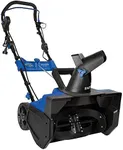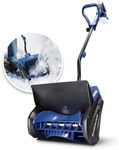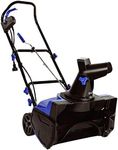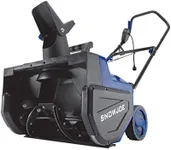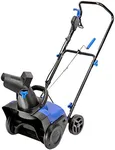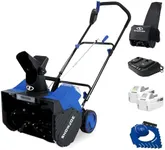Buying Guide for the Best Snow Joe Electric Snow Throwers
Choosing the right electric snow thrower can make a big difference in how easily and efficiently you can clear snow from your driveway, sidewalks, and other areas. When selecting a snow thrower, it's important to consider several key specifications to ensure you get a model that fits your needs. Understanding these specs will help you make an informed decision and find the best snow thrower for your specific situation.Clearing WidthThe clearing width refers to the width of the path that the snow thrower can clear in a single pass. This is important because a wider clearing width means you can clear more snow with fewer passes, saving you time and effort. Clearing widths typically range from about 18 inches to 24 inches or more. If you have a large area to clear, a wider clearing width is beneficial. For smaller areas or tighter spaces, a narrower width may be more maneuverable and sufficient.
Intake HeightThe intake height is the maximum height of snow that the snow thrower can handle. This is crucial for dealing with heavy snowfall. Intake heights can vary from around 10 inches to over 20 inches. If you live in an area that experiences heavy snowfall, a higher intake height will allow you to clear deeper snow more effectively. For areas with lighter snowfall, a lower intake height may be adequate.
Power SourceElectric snow throwers can be corded or cordless. Corded models need to be plugged into an electrical outlet, which can limit your range but provides consistent power. Cordless models run on rechargeable batteries, offering more mobility but requiring recharging. If you have a small to medium-sized area and access to outdoor outlets, a corded model might be suitable. For larger areas or if you prefer more freedom of movement, a cordless model could be a better choice.
Motor PowerMotor power is measured in amps for corded models and volts for cordless models. Higher motor power generally means better performance, especially in heavy or wet snow. Corded models typically range from 10 to 15 amps, while cordless models can range from 40 to 80 volts or more. If you often deal with heavy, wet snow, a more powerful motor will be beneficial. For lighter, powdery snow, a less powerful motor may suffice.
Throw DistanceThrow distance indicates how far the snow thrower can propel the snow. This is important for ensuring that the snow is thrown far enough away from the cleared area. Throw distances can range from about 20 feet to over 30 feet. If you need to clear large areas or want to avoid creating large piles of snow close to your clearing path, a longer throw distance is advantageous. For smaller areas, a shorter throw distance may be adequate.
WeightThe weight of the snow thrower affects how easy it is to maneuver and transport. Lighter models are easier to handle, especially for smaller or less physically strong users. Weights can range from around 30 pounds to over 50 pounds. If you need to carry the snow thrower up and down stairs or have limited physical strength, a lighter model will be easier to manage. For larger, open areas, a heavier model may provide more stability and power.
Additional FeaturesAdditional features such as adjustable handles, headlights, and chute controls can enhance the usability and convenience of the snow thrower. Adjustable handles can make the machine more comfortable to use for people of different heights. Headlights are useful for clearing snow in low-light conditions. Chute controls allow you to easily direct where the snow is thrown. Consider which features are important to you based on your specific needs and preferences.
